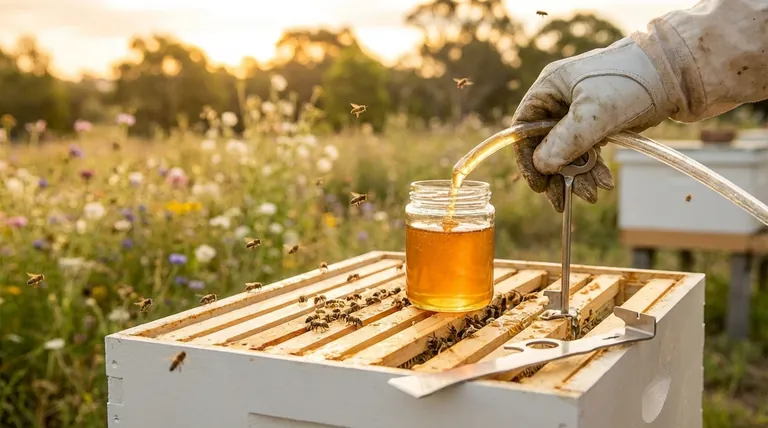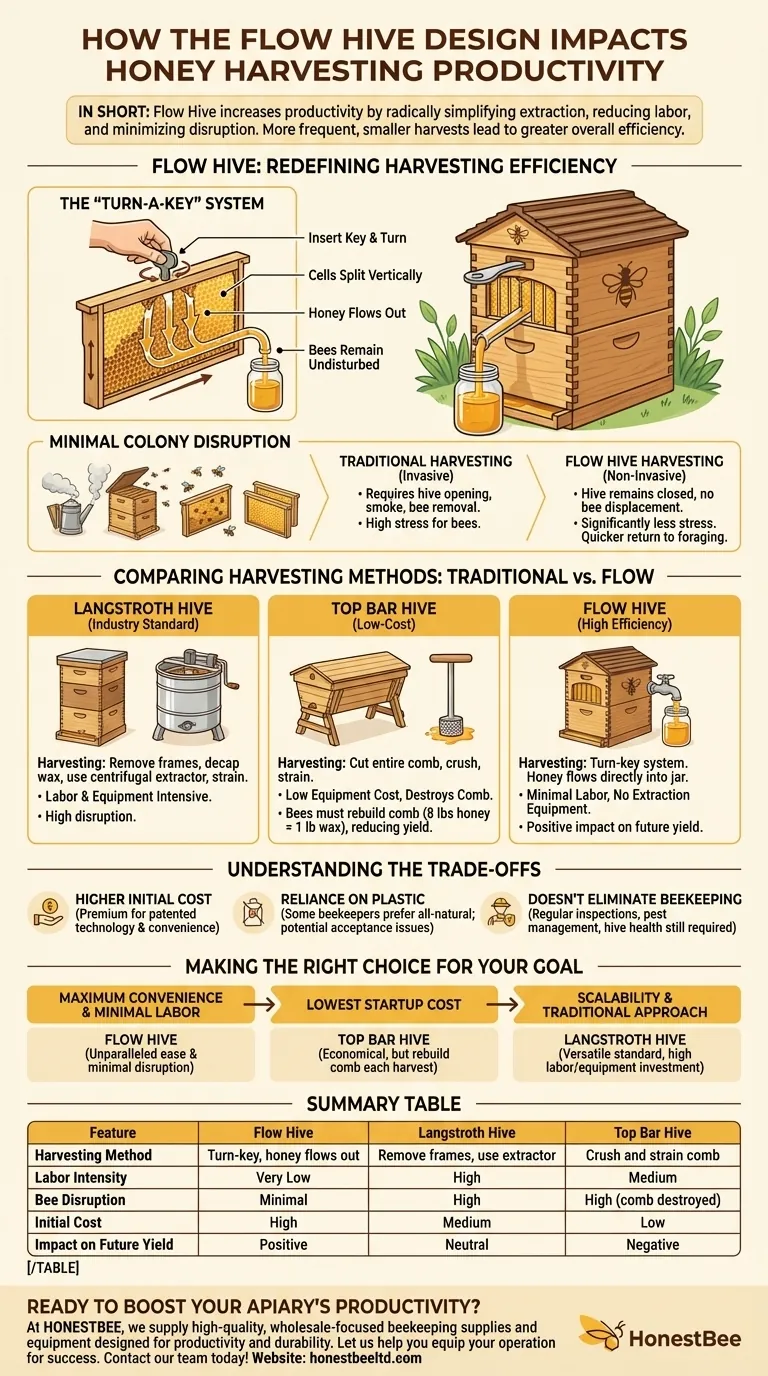In short, the Flow Hive design increases honey harvesting productivity by radically simplifying the extraction process, reducing labor, and minimizing disruption to the bees. This allows for more frequent, smaller harvests throughout a season, which can lead to a greater overall yield compared to the single, intensive harvests typical of traditional methods.
The core value of the Flow Hive is not necessarily a larger single harvest, but a dramatic increase in the efficiency of harvesting. It trades a higher initial financial investment for significant savings in time, labor, and stress on the bee colony.

How the Flow Hive Redefines Harvesting
The primary productivity gain from a Flow Hive comes from changing the fundamental mechanics of how honey is removed from the comb.
The "Turn-a-Key" System
Instead of removing frames, the Flow Hive uses specially designed plastic frames. These frames consist of partially formed honeycomb cells that the bees complete with their own wax and fill with honey.
When you are ready to harvest, you insert a special tool, the Flow Key, into the frame and turn it. This action splits the cells vertically inside the comb.
The honey then flows down through channels within the frame and out a tube directly into your collection jar. The bees remain largely undisturbed on the surface of the comb inside the hive.
Minimal Disruption to the Colony
Traditional harvesting is an invasive process. It requires opening the hive, often using smoke to calm the bees, removing the bees from the frames (using brushes or blowers), and transporting the frames to a separate location for extraction.
The Flow Hive bypasses all of this. Because the hive remains closed and the bees are not physically displaced, the colony experiences significantly less stress. They do not have to spend energy and resources repairing damaged comb, allowing them to return to foraging and producing honey more quickly.
Comparing Harvesting Methods
To understand the Flow Hive's impact, it's essential to compare it to the two most common traditional hive types.
The Langstroth Hive: The Industry Standard
Harvesting from a Langstroth hive is a multi-step, labor-intensive process. It involves removing the frames, cutting the wax cappings off each one with a hot knife, and placing them in a centrifugal extractor that spins the honey out.
This honey must then be strained to remove wax particles. This method requires specialized, expensive equipment, creates a significant mess, and is stressful for the bees.
The Top Bar Hive: The Low-Cost Alternative
A Top Bar hive avoids the need for an expensive extractor. Harvesting is done by cutting the entire comb from the top bar.
The comb is then crushed and strained (often using basic kitchen tools like a masher and cheesecloth) to separate the honey from the wax. While this method has a very low equipment cost, it completely destroys the honeycomb.
The bees must then expend a great deal of energy and consume significant amounts of honey (roughly 8 pounds of honey to produce 1 pound of wax) to rebuild all of that comb from scratch before they can store more honey. This directly reduces the potential for subsequent honey production.
Understanding the Trade-offs
The Flow Hive's convenience is not without its compromises. A clear-eyed assessment is crucial before making an investment.
Higher Initial Cost
The most significant drawback is the price. A Flow Hive is substantially more expensive than a basic Langstroth or Top Bar hive setup. You are paying a premium for the patented Flow Frame technology and the convenience it provides.
Reliance on Plastic Components
The Flow Frames are made of plastic. While they are high-quality and food-grade, some beekeepers prefer to keep their hives entirely free of plastic components, opting for natural wood and wax.
Furthermore, bees can sometimes be slower to accept and build on plastic foundations compared to natural wax. They may also gum up the moving parts of the Flow Frame with propolis, requiring occasional deep cleaning.
It Doesn't Eliminate Beekeeping
The Flow Hive only simplifies the final step of honey harvesting. It does not eliminate the need for essential beekeeping knowledge and regular hive management.
You must still perform regular inspections for pests like Varroa mites, monitor colony health, ensure the queen is laying properly, and manage space within the hive. The Flow Hive makes one task easier; it does not automate beekeeping.
Making the Right Choice for Your Goal
The "best" hive depends entirely on your personal goals, budget, and how you define productivity.
- If your primary focus is maximum convenience and minimal physical labor: The Flow Hive is the unparalleled choice, allowing you to harvest honey with minimal effort and disruption.
- If your primary focus is the lowest possible startup cost: The Top Bar hive offers the most economical entry into beekeeping, though you accept the productivity loss from rebuilding comb each harvest.
- If your primary focus is scalability and a traditional approach: The Langstroth hive is the versatile, industry-standard option, but be prepared for a significant investment in both labor and extraction equipment.
Ultimately, choosing a hive is about aligning the equipment's strengths with your personal investment of time, money, and effort.
Summary Table:
| Feature | Flow Hive | Langstroth Hive | Top Bar Hive |
|---|---|---|---|
| Harvesting Method | Turn-key, honey flows out | Remove frames, use extractor | Crush and strain comb |
| Labor Intensity | Very Low | High | Medium |
| Bee Disruption | Minimal | High | High (comb destroyed) |
| Initial Cost | High | Medium | Low |
| Impact on Future Yield | Positive (minimal disruption) | Neutral | Negative (bees rebuild comb) |
Ready to Boost Your Apiary's Productivity?
Whether you manage a commercial apiary or supply equipment to beekeepers, the right tools are key to efficiency and yield. At HONESTBEE, we supply high-quality, wholesale-focused beekeeping supplies and equipment designed for productivity and durability.
Let us help you equip your operation for success. Contact our team today to discuss your needs and discover how our products can benefit your business.
Visual Guide

Related Products
- HONESTBEE Advanced Ergonomic Stainless Steel Hive Tool for Beekeeping
- Professional Dual-End Stainless Steel Hive Tool for Beekeeping
- HONESTBEE 72 Frame Industrial Electric Honey Extractor for Beekeeping
- 8-Frame Electric Self-Reversing Honey Extractor Spinner for Commercial Honey Extraction Equipment
- Long Langstroth Style Horizontal Top Bar Hive for Wholesale
People Also Ask
- How is a hive tool used for scraping and cleaning? Master Hive Maintenance for a Healthy Colony
- What are some common uses of a hive tool? Essential Multi-Purpose Tool for Every Beekeeper
- How should beekeepers handle bees when using a hive tool? Master Calm, Deliberate Techniques
- What is the hole in a hive tool for? A Multi-Tool for Apiary Repairs and Maintenance
- Why do hive tools have a hole? Unlock the Secret to Efficient Beekeeping



















